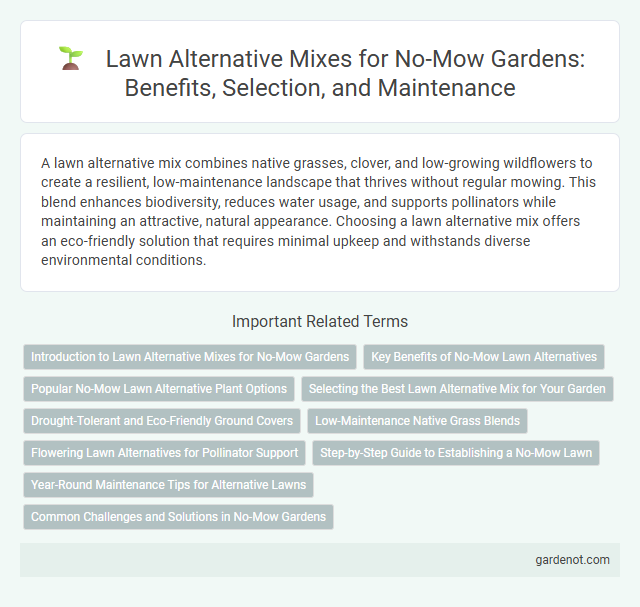A lawn alternative mix combines native grasses, clover, and low-growing wildflowers to create a resilient, low-maintenance landscape that thrives without regular mowing. This blend enhances biodiversity, reduces water usage, and supports pollinators while maintaining an attractive, natural appearance. Choosing a lawn alternative mix offers an eco-friendly solution that requires minimal upkeep and withstands diverse environmental conditions.
Introduction to Lawn Alternative Mixes for No-Mow Gardens
Lawn alternative mixes for no-mow gardens typically combine low-growing, drought-resistant plants like clover, creeping thyme, and native wildflowers, creating a sustainable ground cover that reduces maintenance and water use. These mixes improve soil health, support pollinators, and adapt well to varied climates, making them ideal for eco-friendly landscaping. Choosing the right seed blend is essential for ensuring year-round greenery and durability without regular mowing.
Key Benefits of No-Mow Lawn Alternatives
No-mow lawn alternatives, such as clover, native grasses, and wildflower mixes, reduce maintenance time by eliminating frequent mowing requirements. These eco-friendly options enhance biodiversity, improve soil health, and conserve water by adapting naturally to local climates. Homeowners benefit from lower lawn care costs, increased pollinator support, and a lush, sustainable landscape year-round.
Popular No-Mow Lawn Alternative Plant Options
Clover, fescue, and thyme are popular no-mow lawn alternative plants known for their low maintenance and drought tolerance. These species create a lush, green carpet that requires minimal watering and mowing, making them ideal for eco-friendly landscaping. Incorporating a mix of these plants enhances biodiversity while reducing the environmental impact of traditional lawns.
Selecting the Best Lawn Alternative Mix for Your Garden
Selecting the best lawn alternative mix for your garden involves choosing drought-tolerant grasses, native wildflowers, and clover varieties that reduce maintenance and water usage. Opting for species such as buffalo grass, white clover, and creeping thyme enhances biodiversity while providing a resilient, low-mow surface. Incorporating soil amendments and native perennial seeds tailored to your region ensures optimal growth and environmental sustainability.
Drought-Tolerant and Eco-Friendly Ground Covers
Drought-tolerant ground covers such as clover, creeping thyme, and sedum provide an eco-friendly alternative to traditional lawns by significantly reducing water usage and maintenance. These hardy plants thrive in dry conditions, improve soil health, and promote biodiversity by attracting pollinators. Choosing a no-mow lawn mix with these species minimizes environmental impact while maintaining an attractive, low-maintenance landscape.
Low-Maintenance Native Grass Blends
Low-maintenance native grass blends in no-mow lawns offer drought tolerance and reduced water usage, making them environmentally sustainable choices. These blends typically include species such as buffalo grass, blue grama, and fine fescues, which thrive with minimal mowing and fertilization. Their deep root systems improve soil health and support local biodiversity while maintaining a natural aesthetic.
Flowering Lawn Alternatives for Pollinator Support
Flowering lawn alternatives such as clover, white Dutch clover, and creeping thyme create vibrant, pollinator-friendly habitats that enhance biodiversity while lowering maintenance needs. These no-mow lawn mixes attract bees, butterflies, and other beneficial insects by providing essential nectar and pollen sources throughout the growing season. Incorporating native wildflowers like black-eyed Susan and oxeye daisy further supports local ecosystems and improves soil health by reducing erosion and increasing nitrogen fixation.
Step-by-Step Guide to Establishing a No-Mow Lawn
Choose a drought-tolerant lawn alternative mix containing fine fescues, clover, and buffalo grass for a low-maintenance no-mow lawn. Prepare the soil by removing existing grass, tilling, and leveling to ensure optimal seed-to-soil contact for germination. Sow seeds evenly, lightly rake in, water consistently until established, and reduce watering frequency to maintain a healthy, resilient no-mow lawn.
Year-Round Maintenance Tips for Alternative Lawns
A no-mow lawn alternative mix often includes drought-tolerant clover, native grasses, and low-growing wildflowers that require minimal upkeep. Year-round maintenance involves regular mulching, occasional spot fertilization with organic compost, and targeted watering during extended dry spells to maintain soil health and plant vitality. Seasonal pruning of invasive weeds and monitoring for pests ensures a sustainable, lush landscape without traditional mowing.
Common Challenges and Solutions in No-Mow Gardens
No-mow lawn alternatives often face common challenges such as weed invasion, poor soil health, and inconsistent growth patterns. Solutions include selecting drought-resistant ground covers like clover or creeping thyme, enhancing soil fertility with organic compost, and regular spot maintenance to prevent weed spread. Implementing these strategies results in a sustainable, low-maintenance garden that conserves water and reduces lawn mower use.
Lawn alternative mix Infographic

 gardenot.com
gardenot.com